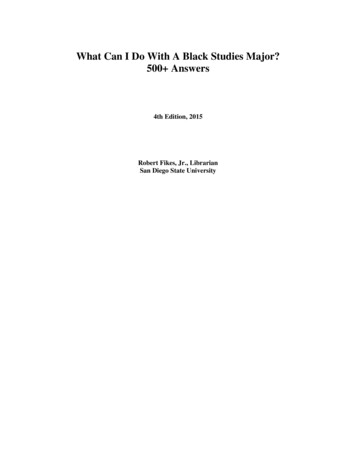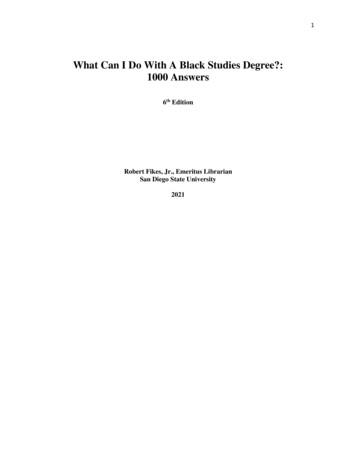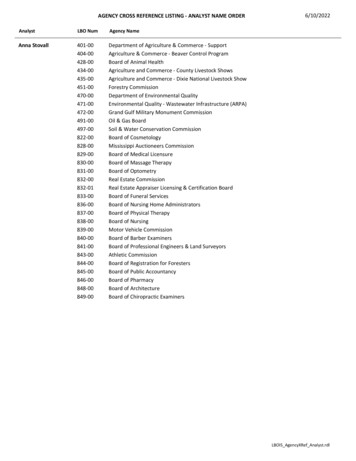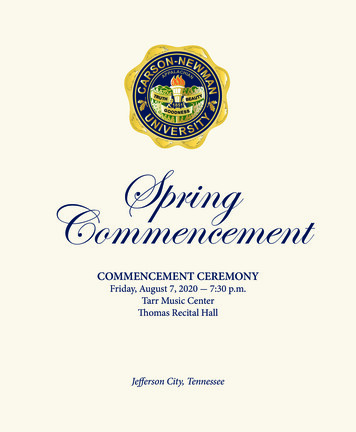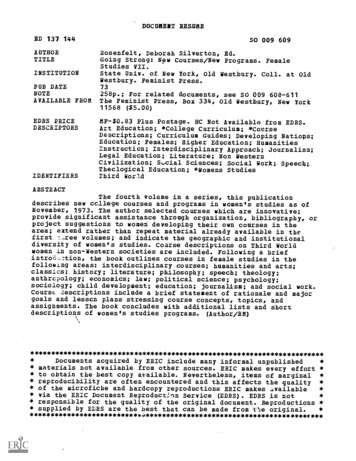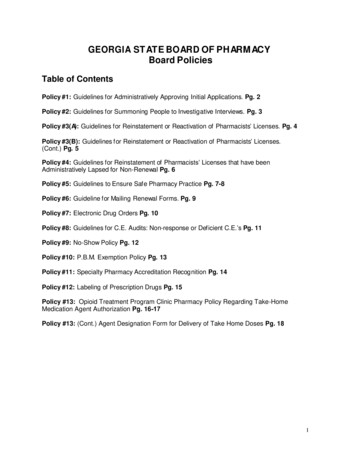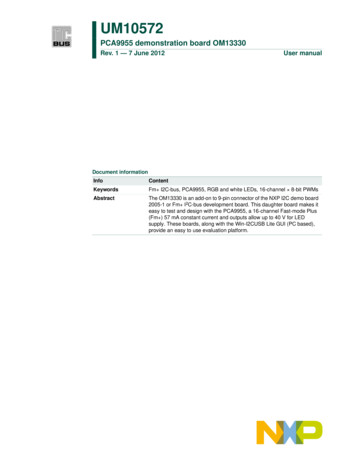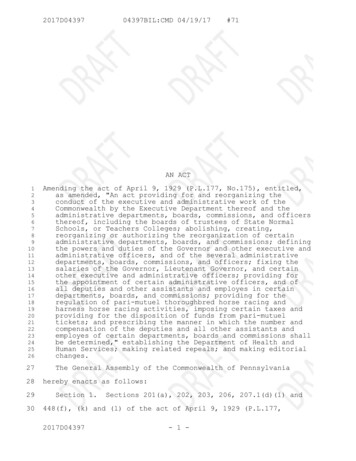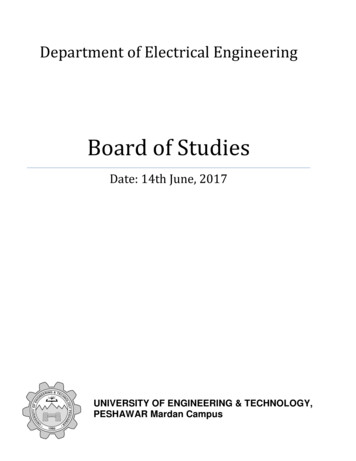
Transcription
Department of Electrical EngineeringBoard of StudiesDate: 14th June, 2017UNIVERSITY OF ENGINEERING & TECHNOLOGY,PESHAWAR Mardan Campus
CURRICULUMOFElectrical Engineering(Undergraduate Program)(14th June, 2017)UNIVERSITY OF ENGINEERING & TECHNOLOGY,PESHAWARMardan Campus1
Table of ContentsB.S. IN ELECTRICAL ENGINEERING PROGRAM SUMMARY . 4SCHEME OF STUDIES FOR UNDERGRADUATE ELECTRICAL ENGINEERING . 7(Communication Group) . 7SCHEME OF STUDIES FOR UNDERGRADUATE ELECTRICAL ENGINEERING . 11(Power Group) . 11Taxonomy Levels . 151st Semester . 16BSI-122 Calculus . 17BSI-151 Electricity and Magnetism . 19ME-105L Engineering Drawing . 22BSI-101 Islamic Studies . 27BSI-120 Professional Ethics . 29BSI-142 English Composition & Comprehension . 312nd Semester . 33BSI-111 Linear Algebra . 34EE-156 Basic Electrical Engineering . 36EE-170 Computer Programming . 39BSI-162 Engineering Mechanics . 42EE-157 Workshop Technology . 45BSI-110 Pakistan Studies . 493rd Semester . 51BSI-231 Differential Equations . 52EE-225 Digital Logic Design . 54EE-200 Circuit Analysis-I . 57EE-271 OOP & Data Structures . 60BSI-143 Communication and Presentation Skills . 634th Semester. 66EE 202- Probability and Random Variables . 67EE-326 Microprocessor & Microcontroller Based System Design . 70EE-201 Circuit Analysis-II . 74BSI-242 Numerical Analysis . 77EE-345 Electronics Devices & Circuits . 805th Semester. 84EE-336 Electrical Measurement & Instrumentation. 85EE-363 Electromagnetic Field Theory . 88EE-497 Electronics Circuit-II (Breath Core-II) . 90EE-287 Engineering Economics . 93BSI-362 Complex Variables & Transforms . 956th Semester. 98EE-312 Signals& Systems . 99EE-286 Technical Report Writing . 1022
CSE-303 Data Communication . 104EE-388 Engineering Management . 107EE-391 Communication Systems . 1097th Semester. 112EE-496 Computer Communication Networks . 113EE-440 Electrical Machines . 116EE-413 Digital Signal Processing . 120EE-4XX Microwave Engineering. 123Final Year Project . 1268th Semester. 127EE-481 Control Systems. 128EE-495 Mobile Networks . 131Power Stream Courses . 133EE-305 Power Electronics (Elective) . 134EE-205 Electrical Power Generation & Utilization (Elective) . 138EE 407 High Voltage Engineering (Elective) . 142EE 406 Power System Protection (Elective) . 146EE-401 Electrical Power Transmission . 1483
B.S. IN ELECTRICAL ENGINEERINGPROGRAM SUMMARYProgram Educational Objectives:The graduates of the program of Bachelors of Electrical Engineering will be equippedwith skills to demonstrate an understanding of key technologies applicable within areasof Electrical and Electronic Engineering. The main objectives of the program are toproduce engineers with:PEO-1PEO-2PEO-3The graduates will serve competently in national and international industryor academia by showing requisite knowledge and skills in the field ofElectrical Engineering.The graduates will exhibit quest for learning and initiative through elevationin education or growth in professional status.The graduates will demonstrate commitment to ethical practices,community service and societal contribution.Duration:Number of semesters:Number of weeks per semester:4 years816-18 (16 weeks for instruction and 2weeks for examination)Total number of Credit Hours (CH): 134 to 138Number of Credit Hours (CH) per semester:15-18Contact hours: One (1) contact hour per week for eachcredit hour of instruction Three (3) contact hours per week foreach credit hour of laboratory work4
Electrical Engineering Revised Curriculum By the Board of Studies June 19, 2017CodeBSI -142BSI -143EE -286BSI -110BSI -101BSI -120EE -287EE -388BSI -122BSI -111BSI -231BSI -362BSI -242BSI -151BSI -162Course TitleThLabNON ENGINEERING(i) HumanitiesEnglish Composition and Comprehension30Communication and Presentation Skills30Technical Report Writing30Pak Studies20Islamic Studies20Professional Ethics20(ii) Management SciencesEngineering Economics20Engineering Management20(iii) Natural SciencesCalculus30Linear Algebra30Differential Equations30Complex Variables30Numerical Analysis30Electricity & Magnetism31Engineering 100EE- 202EE-312EE-326EE-440ENGINEERING(i) ComputingComputer Fundamentals21Computer Programming31Data Structure & Algorithms21(ii) Electrical Engineering FoundationBasic Electrical Engineering31Circuit Analysis-I31Workshop Technology11Circuit Analysis-II31Electronic Devices and Circuits31Digital Logic Design31Engineering Drawing01Probability and Random Variables30Signals & Systems31Microprocessor Based System Design31Electrical Machines31EE-363EE-481EE-391Electromagnetic Field TheoryControl SystemsCommunication SystemsEE -121EE-170EE- 271(iii) EE Core (Breadth)303131CreditKnowledge ture)(Social Science)223333343(Math )(Math )(Math )(Elective Math)(Elective Math)General Physics IGeneral Physics II34344244413444344(iv) EE Specialization Based Electives (Depth)Depth Elective-IDepth Elective-IIDepth Elective-IIIDepth Elective-IVDepth Elective-VME-211Applied Thermodynamics (POWER)(v) IDEE3503IDEE- for Power
Electrical Engineering Revised Curriculum By the Board of Studies June 19, 2017CodeCourse TitleThLabCreditCSE-303Data Communication (COM)314EE-478AEE-478B(vi) Senior Design ProjectProject-I03Project-II03Industrial Training in 205EE-406EE-305CE-230EE Power Engineering Based Electives (Depth)Electrical Machine Design314Electrical Measurement & Instrumentation314Power Systems Engineering314Power distribution and Utilization304Electrical Power Transmission303High Voltage Engineering314Power Generation303Power System Protection303Power Electronics314Hydraulics & Hydraulic MachineryAdvanced Electrical MachinesPower System Stability and ControlRenewable energy systemsDigital signal ProcessingDigital Control SystemAnalog & digital Communication SystemIntegrated Electronic CircuitsPLC and Industrial 2EE-494EE-495EE Communication Engineering Based Electives (Depth)Digital Communication314Digital Signal Processing314Wave Propagation & Antennas303Wireless Communication303Mobile Networks303EE-496EE-497Computer communication n Theory & CodingElectrical Measurement & InstrumentationEE-394Transmission and Switching SystemSatellite EngineeringRF & Microwave EnggDigital Image ProcessingNavigation and Radar SystemAntenna Theory & DesignPower Distribution & utilization333333333010011010343344343Knowledge AreaStreamIDEE- forcommunication stream(Breadth Core-I)(Breadth Core-II)( IDEE-II for powerstream)(Breadth Core-I)(Breadth –Core II)6
SCHEME OF STUDIES FORUNDERGRADUATE ELECTRICALENGINEERING(Communication Group)Semester 1:CodeCredit SI-151Electricity and Magnetism3-3-4ME-100Engineering Drawing0-3-1EE-121Computer Fundamentals2-3-3BSI-101Islamic Studies2-0-2BSI-120Professional Ethics2-0-2BSI-142English Composition and Comprehension3-0-3Total15-3-18Semester 2:CodeCredit Hours(Theory-LabCredits)TitleBSI-111Linear Algebra3-0-3EE-156Basic Electrical Engineering3-3-4EE-170Computer Programming3-3-4BSI-162Engineering Mechanics3-0-3EE-157Workshop Technology1-3-2BSI-110Pak Studies2-0-2Total15-3-187
Semester 3:CodeCredit Hours(Theory-LabCredits)TitleBSI-231Differential Equations3-0-3EE-225Digital Logic Design3-3-4EE-200Circuit Analysis-I3-3-4EE-271Oops & Data Structures2-3-3BSI-143Communication and Presentation Skills3-0-3Total14-3-17Semester 4:CodeCredit Hours(Theory-LabCredits)TitleEE-202 Probability & Random VariablesEE-326Microprocessor & Microcontroller Based SystemDesign3-0-33-3-4EE-201 Circuit Analysis –II3-3-4BSI-242 Numerical Analysis3-0-3EE-345 Electronic Devices & Circuits3-3-4Total15-3-188
Semester 5:CodeCredit Hours(Theory-LabCredits)TitleEE-336 Electrical Measurements & Instrumentation3-3-4EE-363 Electromagnetic Field Theory3-0-3EE-497 Electronic Circuit II (Breadth Core-II)3-3-4EE-287 Engineering Economics3-0-3BSI-362 Complex Variables and Transforms3-0-3Total15-2-17Semester 6:CodeCredit Hours(Theory-LabCredits)TitleEE-312Signals & Systems3-3-4EE-286Technical Report Writing3-0-3CSE-303 Data Communication3-3-4EE-388Engineering Management2-0-2EE-391Communication System3-3-4Total14-3-179
Semester 7:CodeCredit Hours(Theory-LabCredits)TitleEE-496Computer Communication Networks3-3-4EE-440Electrical Machines3-3-4EE-4XX Elective-I3-3-4EE-4XX Elective-II3-3-4EE-478A Project0-9-3Total12-7-19Semester 8:CodeEE-481Credit Hours(Theory-LabCredits)TitleControl Systems3-3-4EE-4XX Elective-III3-0-3EE-4XX Elective-IV3-3-4EE-478B Project0-9-3Total9-5-14Total Credit Hours 138Note: Code for the Laboratory part of a corresponding course will be followed by Letter L.10
SCHEME OF STUDIES FORUNDERGRADUATE ELECTRICALENGINEERING(Power Group)Semester 1:CodeCredit SI-151Electricity and Magnetism3-3-4ME-100Engineering Drawing0-3-1EE-121Computer Fundamentals2-3-3BSI-101Islamic Studies2-0-2BSI-120Professional Ethics2-0-2BSI-142English Composition and Comprehension3-0-3Total15-3-18Semester 2:CodeCredit Hours(Theory-LabCredits)TitleBSI-111Linear Algebra3-0-3EE-156Basic Electrical Engineering3-3-4EE-170Computer Programming3-3-4BSI-162Engineering Mechanics3-0-3EE-157Workshop Technology1-3-2BSI-110Pak Studies2-0-2Total15-3-1811
Semester 3:CodeCredit Hours(Theory-LabCredits)TitleBSI-231Differential Equations3-0-3EE-225Digital Logic Design3-3-4EE-200Circuit Analysis-I3-3-4ME-211Applied Thermodynamics3-0-3EE-271Oops & Data Structures2-3-3BSI-143Communication and Presentation Skills3-0-3Total17-3-20Semester 4:CodeCredit Hours(Theory-LabCredits)TitleEE-202 Probability & Random VariablesEE-326Microprocessor & Microcontroller Based SystemDesign3-0-33-3-4EE-201 Circuit Analysis –II3-3-4BSI-242 Numerical Analysis3-0-3EE-345 Electronic Devices & Circuits3-3-4Total15-3-1812
Semester 5:CodeCredit Hours(Theory-LabCredits)TitleEE-336 Electrical Measurements & Instrumentation3-3-4EE-363 Electromagnetic Field Theory3-0-3EE-230 Elective-I3-3-4EE-287 Engineering Economics3-0-3BSI-362 Complex Variables and Transforms3-0-3Total15-2-17Semester 6:CodeCredit Hours(Theory-LabCredits)TitleEE-312Signals & Systems3-3-4EE-286Technical Report g Management2-0-2EE-391Communication System3-3-4Total14-3-1713
Semester 7:CodeCredit Hours(Theory-LabCredits)TitleEE-394Power Distribution & Utilization3-0-3EE-440Electrical Machines3-3-4EE-4XX Elective-III3-3-4EE-478A Project0-9-3Total9-5-14Semester 8:CodeEE-481Credit Hours(Theory-LabCredits)TitleControl Systems3-3-4EE-4XX Elective-IV3-0-3EE-4XX Elective-V3-3-4EE-478B Project0-9-3Total9-5-14Total Credit Hours 136Note: Code for the Laboratory part of a corresponding course will be followed by Letter L.14
Taxonomy Levels15
1st Semester16
BSI-122 CalculusContact Hours:Credit Hours:Theory 48Theory ---------------------------------------Course outcome:COURSE LEARNING OUTCOMES:Upon successful completion of the course, the student will be able to:S.CLODomainTaxonomy levelNo.1.Understand the ideas of rate of changeCognitive 1and derivatives using the concept oflimits and continuity.2.Use the techniques of integration forCognitive 3solving and analyzing problems inintegral calculus.3.Apply the derivatives for solvingCognitive 3different problems arising in engineeringsciences.4.Use the vector calculus and analyticalCognitive 3geometry in multiple dimensions to solvedifferent problems.PLO1233RELEVANT PROGRAM LEARNING OUTCOMES (PLOs):The course is designed so that students will achieve the following PLOs:1Engineering Knowledge: 72Problem Analysis: 34Design/Development ofSolutions:Investigation:56 8Environment andSustainability:Ethics: 9Individual and Team Work: 10 Communication: Modern Tool Usage: 11 Project Management: The Engineer and Society: 12 Lifelong Learning: Course outline:Type of Functions (continuous, periodic, odd, even), graphs of functions, Limits andcontinuity, Derivatives, total differential, Higher odder derivative, Tangents and normal,approximation by Taylor and McLaurin’s, Maxima & Minima and Point of inflection, Integral17
Calculus (basic concepts, Integral formula, some rules of integral), Integration by parts, areabounded by curve, volume of revolution.Multivariate Calculus (Basic Concept, level curves and surfaces, limits and continuity), PartialDerivative, Higher order partial derivative, tangent plan, total differential, Vector functions itsderivative and integration, Directional derivative, gradient, scalar and vector, Normal propertyof gradient, diversions, curl, Tangent plans and normal lines, extrema of function of twovariable, Second partial test, extreme value theorem, Method of constrained optimization andLagrange multiplier.Teaching Methodology LecturingWritten AssignmentsQuizzesAssessmentSessional (25%) Assignments 60% Quizzes 40%Mid Term (25%)Final Term (50%)Text book: Calculus by Thomas Finney, Addison-Wesley Publishing Company. Mathematics for Engineer 2nd Edition by Robert Davison. Multivariate Calculus 2nd Edition by Robert T. Smith.18
BSI-151 Electricity and MagnetismContact Hours:Credit Hours:Theory 48Theory 3.0Practical 48Practical 1.0Total 96Total ---------------------------------------Course outcome:COURSE LEARNING OUTCOMES:Upon successful completion of the course, the student will be able to:S.CLODomainTaxonomy levelNo.1.Describe and explain the fundamentalCognitive 2physical principles.2.Apply these principles, together withCognitive 3logical and mathematical reasoning, tosituations of the physical world.3.Analyze different physical problemsCognitive 4using the laws of physics.PLO122RELEVANT PROGRAM LEARNING OUTCOMES (PLOs):The course is designed so that students will achieve the following PLOs:1Engineering Knowledge: 72Problem Analysis: 34Design/Development ofSolutions:Investigation:56 8Environment andSustainability:Ethics: 9Individual and Team Work: 10 Communication: Modern Tool Usage: 11 Project Management: The Engineer and Society: 12 Lifelong Learning: Course outline:Atomic structure, energy bands, electric charge, conductors and insulators, Coulomb’slaw, electric field, field due to a point-charge, electric dipole and line of charge, flux ofan electric field, Permitivity of a medium, Guass’s law, electric potential, calculatingthe potential from electric field, potential due to a point-charge and a group of point19
charges, potential due to a dipole and due to a continuous charge distribution, energystored in electric field, capacitors, calculating capacitance, capacitors in series andparallel, capacitors with dielectrics, Time varying capacitors, Factors affectingcapacitance, Application of Capacitors, electric current and current density, resistanceand resistivity, Ohm’s law, resistors in series and parallel, temperature dependence ofresistance and other factors affecting resistance, application of resistors.The magnetic field, a circulating charged particle, magnetic dipole, magnetic force on acurrent carrying conductor, torque on a current-loop, magnetic field due to current,force between two parallel current-carrying conductors, Biot Savart law and itsapplications, Ampere’s law, inductance and inductors, Factors affecting inductance,permeability, inductors geometry, solenoids and toroids, inductors in series andparallel, Application of Inductors, Faraday’s law of induction, Lenz’s law, energystored in a magnetic field, induction and energy transfers, Magnets and magneticmaterials, Dia-, Para- and Show knowledge of constructing basiccircuits.Effectively employ classroomknowledge and laboratory techniquesfor demonstration of relevant theoremsof electricity and magnetism.Taxonomy levelPsychomotor 21Psychomotor 31DescriptionsDetermine the resistance of a Galvanometer by Kelvin method.2.Convert a Galvanometer into an Ammeter.3.Convert the Galvanometer in to Voltmeter.4.Study the Capacitance and Dielectric of Parallel plate capacitor.5.Study Variation of Resistance in Metal & semiconductor.6.Calibrate the thermocouple by deflection method.7.Find the frequency of A.C Main by Sonometer.20PLO
8.To determine the value of given high resistance by Leakage method9.To study the variation of Photoelectric current with intensity of incidentbeam.10.To determine the angle of dip by earth inductor method.11.To determine the value of a given resistance by color coding.12.To Verify Ohm’s law.Teaching Methodology LecturingWritten AssignmentsQuizzesAssessmentSessional (25%) Assignments 60% Quizzes 40%Mid Term (25%)Final Term (50%)Text book: Physics vol.2, By Halliday David Halliday, et. Al. Fundamentals of Physics, 6th edition, by David Halliday, et. al.Reference book: University Physics By Young, Freedman, 9th Edition, University Physics By Young, Sears and Zemanky21
ME-105L Engineering DrawingContact Hours:Credit Hours:Practical 48Practical ---------------------------------------Course outcome:COURSE LEARNING OUTCOMES:Upon successful completion of the course, the student will be able to:S.CLODomainTaxonomy levelNo.1.Understand the basic technique andCognitive1tools of engineering drawing andgraphics as a language ofcommunication.2.Draw 2-D and 3D Drawings/SketchesPsychomotor 3using AutoCAD drawing and editingtools.3.Drawing projects related to ElectricalPsychomotor 3Engineering applications by use ofDESIGN CENTER tool in AutoCAD.PLO153, 5RELEVANT PROGRAM LEARNING OUTCOMES (PLOs):The course is designed so that students will achieve the following PLOs:1Engineering Knowledge: 72Problem Analysis: 34Design/Development ofSolutions:Investigation:56 8Environment andSustainability:Ethics: 9Individual and Team Work: 10 Communication: Modern Tool Usage: 11 Project Management: The Engineer and Society: 12 Lifelong Learning: Course outline:Computer Aided Drawing Introduction:Drawing instruments and their uses, types of lines, lettering and planning of adrawing, planning of a drawing sheet, principle requirements of a working drawing.22
Preliminary consideration: An overview of AutoCAD, hardware requirement,installing and configuring AutoCAD.Managing an AutoCAD drawing:The drawing environment, Controlling and accelerating the drawing process, creatingsimple drawings, creating complex entities. Editing and plotting drawings: Editingdrawing entities, changing the drawing display, printing and plotting the drawings,measuring different variables, designing shapes and text fonts. Autolisp: syntax andstructure of Autolisp, Autolisp functions, manipulating block attributes,communication and merger with other ion to AutoCAD & Its environment.2D commands: Line, Arc, and Circle by different methods. Coordinates system.Modify Commands: Erase, Explode, Reinserting etc.Ellipse, Spline, Polygon, Statusbar Options like Snap, Osnap, Lwt etc. Listcommand, Point, Locating a point, Calculating Area, Measuring Distance, Units.Modify Commands like Move, Copy, Offset, Extend, Trim, Mirror, Rotate,Scale, Break, Stretch, Fillet, Chamfer, Array (Rectangular Circular), Lengthen.Polyline command and its options. etc Pedit15.16.17.Dimensions and its Styles, Making Layers, Block Making and its Insertion,Hatch command.User Coordinate System (UCS), Text and its options, Design Center. ExternalReference i.e. Xref command.3D Commands: Extrude, Taper extrude, Extrude along a path, Extrude Curves,Solid Composite like Union, Subtract, Intersect. 3D orbit commands, VisualizingThe model.Conversion of Pictorial view into orthographic Projections. Dimensioning theviews with complete Specifications. Viewports Layers.3D Editing like Align, Rotate, Mirror, Array (Rectangular Circular). RevolveCommandSolids like Cube, Sphere, Cylinder, Isolines, Facetres, Cone, Wedge, Torus, 3DView ports, Controlling View Ports, 3D surfaces.Solid Editing Commands like Extrude face, Shell, Rotate face, Taper face etc.18.19.20.21.22.23.24.Teaching Methodology LecturingAssignmentsQuizzes23
AssessmentSessional (25%) Assignments 40% Quizzes 60%Mid Term (25%)Final Term (50%)Text book: Elementary Engineering Drawing, Revised and Enlarged Edition by N. D. Bhatt. First year engineering drawing by A.C. Parkinson. Introduction to AutoCAD 2009 2D and 3D Design by Alf Yarwood, FirstEdition.24
EE-121 Computer FundamentalsContact Hours:Credit Hours:Theory 48Theory 3.0Practical 48Practical 1.0Total 96Total ---------------------------------------Course outcome:COURSE LEARNING OUTCOMES:Upon successful completion of the course, the student will be able to:S.CLODomainTaxonomy levelNo.1.Understand the working of computerCognitive 1hardware and software.2.Understand the principles of binaryCognitive 1arithmetic and logic.3.Demonstrate problem solving skills andCognitive 3develop small scale computer programs.4.Understand the concepts of dataCognitive 1communication and networks.PLO111, 31RELEVANT PROGRAM LEARNING OUTCOMES (PLOs):The course is designed so that students will achieve the following PLOs:1Engineering Knowledge: 72Problem Analysis:34Design/Development ofSolutions:Investigation: 10 Communication: 5Modern Tool Usage: 11 Project Management: 6The Engineer and Society: 12 Lifelong Learning: 8Environment andSustainability:Ethics:9Individual and Team Work: Course outline:Brief History of Computing, Key strengths and weaknesses of the modern computer,Computer Types According to Capability, Intro to Microprocessor & Binary logic,Number System used in Computers. Range of Numbers a computer can handle, Typesof Software, System Software, Application Software, Types of Software License,Operating System, Application Software, Computer Networks, introduction to theInternet, Databases, Cybercrime, and Introduction to Programming in Matlab. Focus25
will be on HTML and ability to creating Web pages using HTML and off the shelfproject, Web Hosting etc.Practical:S.No.1.2.3.LODomainUnderstand the working of hardwarecomponents of computer.Improve typing speed and developoffice application skills.Demonstrate problem solving skills bydeveloping computer programs.S.No25.Taxonomy levelPLOPsychomotor 11Psychomotor 31Psychomotor 41, 3DescriptionsIntroduction to the very basics of the internet e.g. using search engines, usingWikipedia, checking your Email.Personal computer components, inside the CPU.Introduction to typing tutors, typing practice.Introduction to MS Word.Introduction to MS Power point.Introduction to MS Power point.Introduction to MS Excel.Introduction to MS Excel.Introduction to HTMLIntroduction to HTML codes.Writing small HTML codes.Introduction to web designing.Introduction to web oduction to programming languages.38.Introduction to programming languages.39.Teaching Methodology LecturingWritten AssignmentsQuizzesAssessmentSessional (25%) Assignments 60% Quizzes 40%Mid Term (25%)Final Term (50%)Text book:Introduction to Computers by Peter Norton, 8th Edition.26
BSI-101 Islamic StudiesContact Hours:Credit Hours:Theory 48Theory ---------------------------------------Course outcome:COURSE LEARNING OUTCOMES:Upon successful completion of the course, the student will be able to:S.CLODomainTaxonomy levelNo.1.Value basic concepts of Islam (faith,Affective 3pillars, dawat, preaching and seerat).2.Compilation of the Holy Quran and Basic Affective 2Concepts of Hadith.3.Present Islam as a complete code of life.Affective 2PLO12128, 12RELEVANT PROGRAM LEARNING O
BSI-142 English Composition and Comprehension 3-0-3 Total 15-3-18 Code Title Credit Hours (Theory-Lab-Credits) BSI-111 Linear Algebra 3-0-3 EE-156 Basic Electrical Engineering 3-3-4 EE-170 Computer Programming 3-3-4 BSI-162 Engineering Mechanics 3-0-3 EE-157 Workshop Technology 1-3-2 BSI-110 Pak Studies 2-0-2 Total 15-3-18

